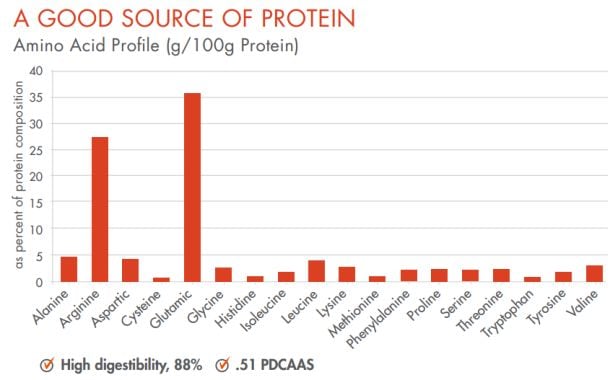One of a series of algae-based ingredients in TerraVia's portfolio, the AlgaVia protein-rich whole algae ingredient contains around 63% protein, along with fiber, lipids and micronutrients such as lutein and zeaxanthin.
Unlike pea protein - the fastest-growing plant-based protein - AlgaVia protein has a neutral taste, and does not interact with other ingredients in a formulations as the cell wall of the algae remains intact, meaning that it remains stable in a variety of temperatures and pH conditions, and it does not add viscosity or grittiness, claims San Francisco-based TerraVia.
Similarly, in a low PH beverage such as tropical fruit juice smoothie, for example, you don’t need to add stabilizers to stop the protein from falling out of the solution, ensuring labels stay clean, said Mark Brooks, SVP and General Manager of TerraVia’s Food and Ingredients business.
“Its limited interaction with other ingredients is a key competitive advantage over other sources of plant-based proteins. When used in formulations, the protein and nutrients are protected by the algae cell wall.
“This protection enables fortification in challenging applications such as low pH beverages, doughs, smooth dressings and low-moisture products like crackers – and with no impact on viscosity at up to 20% inclusion. This means beverages stay clean and crisp and foods don’t become thick and dry over time.”
Paler version enables use in a wider range of color-sensitive applications
It is grown from a native microalgae strain (chlorella) that naturally converts sugars into oils and proteins via a fermentation process, after which it is harvested, washed, dried and milled into a fine, golden yellow powder.
(TerraVia also has a paler version for dairy, beverage and baking segments “allowing use in a wider range of color-sensitive applications and a higher inclusion rate than the existing varieties," says Brooks).
From a nutritional perspective, meanwhile, whole algae protein is highly digestible, and has a full complement of amino acids (particularly arginine and glutamic acid), coupled with dietary fiber, healthy fats and micronutrients such as lutein and zeaxanthin.
We are excited to have active projects underway in a breadth of new arenas
But how is the ingedient - the GRAS determination of which was subject to a ‘no questions’ letter from the FDA - performing in the market?
Many projects are still in the development stage, but AlgaVia is slowing creeping into more products US grocery shelves including OLLY protein smoothies (soon to be available in 1,800 Target stores), Enjoy Life Foods baking mixes, and K’ul Chocolate, while scores more are in the development phase as formulators look for new vegan, non-allergenic sources of protein, claimed Brooks.
“Currently, it can be found in numerous foods and brands across the grocery store – including bakery, snacks, beverages, nutritional meals, and bars. Consumers can expect to see more products in the year ahead, as we’ve been working with leading food companies and sustainable food innovators in the US, Europe and South America.
“We are excited to have active projects underway in a breadth of new arenas, including savory snacks, salad dressings, cereals, cheese analogs, cookies, coatings, cooking sauces, yogurts and RTM supplements.”

Pricing not a barrier, claims TerraVia
However, what really gives it the edge over rivals is that it is vegan, non-allergenic, non-GMO, and arguably ‘greener’ than rival sources of protein in that it can effectively be made to order – in a matter of days – does not require the cultivation of large tracts of agricultural land, and is highly scalable, said Brooks.
“It also provides a rich collection of dietary fiber, healthy lipids and micronutrients such as lutein and zeaxanthin."
Asked whether price was holding back growth, Brooks said: “Price has not been an impediment among manufacturers seeking alternative sources [of protein].
"Our customers have recognized the superior value of our algae protein as a way to bring distinctive value to their products as it offers an unparalleled value proposition that is free of known allergens, gluten-free, non-GM and has a neutral flavor profile and texture."
What's in a name?
AlgaVia protein-rich whole algae is listed in several different ways on pack, with Enjoy Life Foods describing it as ‘algal protein’ and OLLY calling it ‘Golden chlorella,’ says TerraVia SVP Mark Brooks, who added: “Our consumer research suggests ‘whole algae protein’ as the leading solution because it most clearly highlights both the origin of the protein and the presence of other macro and micronutrients like fiber.”
Given that algae - a diverse group of aquatic organisms – are not always described as plants, is it accurate to describe AlgaVia as a ‘plant-based protein’?
According to Brooks: “Many people consider microalgae to be a plant, and what is indisputable is that algae is the mother of all plants and shares many of the same capabilities and attributes as higher plants... And marketers like the story of going back to one of earth’s oldest nutrient sources.
"AlgaVia protein-rich whole algae is a vegan product that is an ideal complement to plant-based diets. It has also enabled food and beverage manufacturers working with plant-based proteins to think differently about how they can formulate foods with greater freedom on texture, taste, sustainability and health."
Consumers like the ‘whole food’ aspect
But are potential customers happy with a 63% protein powder or do they also want concentrates and isolates?
According to Brooks: “Being a whole food has resonated well with consumers because they value the multi-nutrient content and because they know elements have not been extracted. For a majority of mainstream, everyday products, the protein content is acceptable, especially when combined with the often superior overall sensory experience our ingredient affords.”
Watch our interview with TerraVia CEO Jonathan Wolfson at this year's IFT show:
